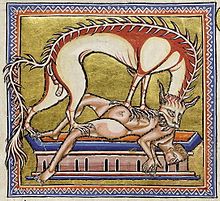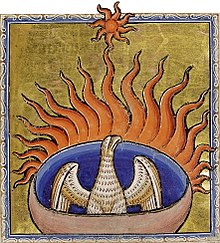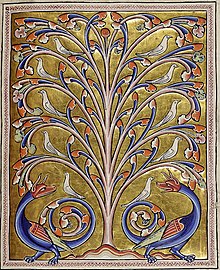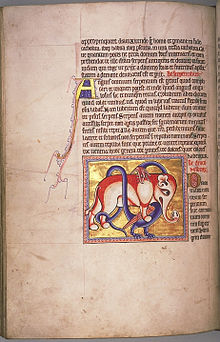Aberdeen Bestiary
The Aberdeen Bestiary ( University of Aberdeen , Library, Univ Lib. MS 24) is an illuminated manuscript that was probably made in England towards the end of the 12th century. A bestiary is a medieval description of animals and mythical creatures.
history
The illuminated manuscript with the designation No.518 Liber de bestiarum natura was first mentioned in 1542 in the inventory of the Old Royal Library in the Palace of Westminster . The exact history and origin of the bestiary cannot be clearly proven. In a library catalog of the Marischal College Library in Aberdeen from 1726, damage or text extraction was noted for the first time. The Aberdeen Bestiary is very similar to the so-called Ashmole Bestiary (MS. Ashmole 1511), which is deposited in the Bodleian Library at Oxford University . Despite differences in several representations, it is assumed that the illuminated manuscripts come from the same hand, even if they were created at different times.
At the beginning of the 20th century, the ancient researcher MR James divided the bestiaries known to him into four families based on their content . The bestiary of Aberdeen is therefore one of about 20 known copies of the so-called Second Family (Second Family) that have arisen during the 12th century. The first family included the allegorical theory of nature Physiologus and the Etymologiae of Isidore of Seville . In comparison, the Aberdeen Bestiary has almost twice the number of chapters, with additional materials, etc. a. from De mirabilibus mundi by Solinus and Hexaemeron by Ambrosius , and is structured according to the categories of Isidore.
Content and equipment
The manuscript, written in Latin, contains 103 folia on parchment and measures 30.2 × 21 cm.
The Aberdeen Bestiary is one of the few bestiaries that incorporates the story of creation. It also contains texts and pictures about birds from the De avibus of Hugh of Fouilloy were taken.
According to the method of counting leaves (folium) in handwriting , in the following recto , abbreviated r , stands for front and verso , abbreviated v , for back.
The creation











- fol.1r: Creation account of the creation of heaven and earth ( Genesis 1: 1–5)
- fol.1v: Creation of the vault of heaven and separation of the water ( Genesis 1: 6–8)
- fol.2r: Creation of birds and fish ( Genesis 1: 20-23)
- fol. 2v: Creation of animals ( Genesis 1: 24-25)
- fol.3r: Creation of the people Adam and Eve ( Genesis 1: 26-28, 31; 2: 1-2)
- fol. 4v: Jesus Christ on his throne, Majestas Domini , ( Revelation of John , 4–5; Gospel of Matthew , 25.31)
- fol.5r: Adam gives the animals their names (illustration of a text by Isidore of Seville, Etymologiae , Book XII, 2,1–8; XII, 8,1–9)
- fol.5v: Text: Adam gives the animals their names (Omnibus animantibus)
- fol.5v: Quadrupedie (Quadrupes) (Isidore of Seville, Etymologiae , Book XII, 1,4)
- fol.5v: Cattle (Pecus) (Isidore of Seville, Etymologiae , Book XII, 1,5–6)
- fol.5v: Pack animals (Iumentum) (Isidore of Seville, Etymologiae , Book XII, 1,7)
- fol.5v: Herd (Armentum) (Isidore of Seville, Etymologiae , Book XII, 1,8)
Wild animals (Bestiae)
- fol.7r: Incipit liber de naturis bestiarium (beginning of the book on the nature of animals)
- fol.7r: De leonibus. ( Panthera leo ; lion ) ( Physiologus , chap. 1; Isidore of Seville, Etymologiae , book XII, 2,3–6)
- fol.8r: Tigris. ( Panthera tigris ; tiger ) (Isidore of Seville, Etymologiae , Book XII, 2,7)
- fol.8v: De Pardo. ( Panthera pardus ; leopard ) (Isidore of Seville, Etymologiae , Book XII, 2.10–11)
- fol.9r: De Panthera. ( Panthera ; Panther ) ( Physiologus , chap. 16; Isidore of Seville, Etymologiae , Book XII, 2,8-9)
Compared to the Ashmole Bestiary, fol. 9v lacks the pages on which the following animals are listed: the antelope (Antalops) , the unicorn (Unicornis) , the lynx (Lynx) , the griffin (Gryps) and a section on the elephant (Elephans) .
- fol.10r: De Elephante. ( Elephantidae ; Elephant ) (Isidor von Sevilla, Etymologiae , Book XII, 2.14; Physiologus , Chap. 43; Ambrosius, Sechstagewerk , Book VI, 35; Solinus , Collectanea rerum memorabilium , xxv, 1-7)
- fol.11r: De Castore. ( Castor ; beaver )
- fol.11r: De animali quod dicitur ibex. ( Capra ibex ; Alpine Ibex )
- fol.11v: De Yena. ( Hyaena ; Hyaena ) ( Physiologus , chap. 24; Solinus, Collectanea rerum memorabilium , xxvii, 23–24)
- fol.12r: De bonnacon. ( Mythical creatures ; Bonnacon ) (Solinus, Collectanea rerum memorabilium , xl, 10–11)
- fol.12v: Simie. ( Anthropoidea ; monkey )
- fol.13r: De satiris. ( Hybrid creature ; satyr )
- fol.13r: De cervis. ( Cervidae ; deer )
- fol.13v: De cervis. continued
- fol.14r: De capre. ( Capra ; goats )
- fol.14v: Caprea. ( Capra aegagrus ; wild goat )
- fol.15r: De monocero. ( Mythical creatures ; unicorn ) (Solinus, Collectanea rerum memorabilium , lii, 39–40)
- fol.15r: De urso. ( Ursidae ; bears )
- fol.15v: De leucrota. ( Leucrota ) (Solinus, Collectanea rerum memorabilium , lii, 34)
Compared to the Ashmole Bestiary, fol. 15v lacks the pages on which the following animals are listed: crocodiles (Crocodilus) , the manticore (Mantichora) and a section of the Parandrus (Parandrus) .
- fol.16r: De parandro. ( Fabeltier ; Parandrus ) (Solinus, Collectanea rerum memorabilium , xxx, 25)
- fol.16r: De vulpe. ( Vulpini ; fox )
- fol.16v: De eale. ( Mythical creature ; Yale ( mythical beast) ) (Solinus, Collectanea rerum memorabilium , lii, 35)
- fol.17r: De lupo. ( Canis lupus ; wolf )
- fol.17v: De lupo. continued
- fol. 18r: De natura canum. ( Canidae ; dogs )
- fol. 18v: De natura canum. continued
- fol. 19r: De natura canum. continued
- fol.19v: De natura canum. continued
- fol.20r: De natura canum. continued
The cattle (Pecora)
- fol.20v: De ove. ( Ovis ; sheep ) ( Isidore of Seville , Etymologiae , Book XII, 1,9; Ambrosius, Sechstagewerk , Book VI, 20)
- fol.21r: De vervece. ( Ovis gmelini aries ; Bock ) (Isidore of Seville, Etymologiae , Book XII, 1,10–11)
- fol.21r: De agno. ( Ovis gmelini aries ; lamb ) (Isidore of Seville, Etymologiae , Book XII, 1.12; Ambrosius, Sechstagewerk , Book VI, 28)
- fol.21r: De hyrco. ( Capra aegagrus hircus ; domestic goat ) (Isidore of Seville, Etymologiae , Book XII, 1.14)
- fol.21v: Hedus. ( Capra aegagrus hircus ; goat boy ) (Isidore of Seville, Etymologiae , Book XII, i, 13)
- fol.21v: De apro. ( Sus scrofa ; wild boar ) (Isidore of Seville, Etymologiae , Book XII, 1.27)
- fol.21v: De iuvenco. ( Bos taurus ; domestic cattle ) (Isidore of Seville, Etymologiae , Book XII, i, 28)
- fol.21v: Taurus . ( Bos taurus ; bull ) (Isidore of Seville, Etymologiae , Book XII, 1.29)
Compared with the Ashmole bestiary, two pages are missing according to fol. 21v, on which the following animals are listed: the ox (Bos) , the camel (Camelus) , the dromedary (Dromedarius) , the domestic donkey (Asinus) , the wild ass onager (Onagro ) and part of the section on the horse (Equus) .
- fol. 22r: De equo part. ( Equus caballus ; horse ) (Isidore of Seville, Etymologiae , Book XII, 1.41–56; Hugh of Fouilloy, III, xxiii)
- fol.22v: De equo part. continued
- fol.23r: Mulus. ( Hybrid ; mule ) (Isidore of Seville, Etymologiae , Book XII, 1.57–60)
Small animals (Minuta animala)
- fol.23v: De musione. ( Felis silvestris catus ; cat ) (Isidore of Seville, Etymologiae , Book XII, 2.38)
- fol.23v: De muribus. ( Mus ; mouse ) (Isidore of Seville, Etymologiae , Book XII, 3,1)
- fol.23v: De mustela. ( Mustela ; Wiesel ) (Isidore of Seville, Etymologiae , Book XII, 32; Physiologus , Chap. 21)
- fol.24r: De talpa. ( Talpidae ; Mole ) (Isidore of Seville, Etymologiae , Book XII, 3.5)
- fol.24r: De ericiis. ( Erinaceidae ; hedgehog ) (Isidore of Seville, Etymologiae , Book XII, 3,7; Ambrosius, Sechstagewerk , VI, 20)
- fol.24v: De formicis. ( Formicidae ; ants ) (Physiologus, 12; Ambrosius, Sechstagewerk , Buch VI, 16,20)
The birds (Aves)
- fol. 25r: Hic incipit de avibus. ( Aves ; birds )
- fol. 25v: De pennis deargentatis columbe. ( Columba ; doves , see Psalms, 68:13)
- fol. 26r: De columba et accipitre. Pigeons and hawks ( Accipitridae ; hawk species )
- fol.26v: Hic incipit de tribus columbis. (Pigeons, continued)
- fol.27r: Mistice de columba. (The mystical aspects of the dove)
- fol.27v: Item de columba. (Also about the pigeon)
- fol. 28r: De columbe pedibus. De pennis deargentatis. (The dove's feet and feather)
- fol. 28v: De posterioribus dorsi columbe. De color alarum. (The colors and tail feathers of the pigeon)
- fol. 29r: De oculis columbe. De color reliqui corporis. De diversis proprietatibus columbe. (The eyes, the color, the character of the pigeon)
- fol. 29v: De aquilone et austro ventis. (About the north wind and the south wind; wind direction )
- fol.30r: Item de accipitre . (About the hawk)
- fol.31r: De turture. ( Streptopelia turtur ; turtledove )
- fol.32v: De palma. De palma et turture. ( Arecaceae ; palm ( Palma ))
- fol.33v: De cedro. ( Cedrus ; cedar )
- fol.34v: De pellicano. ( Pelecanus ; pelicans )
- fol.35v: De nicticorace. ( Nycticorax nycticorax ; night heron )
- fol.36r: De epopo. ( Upupidae ; hoopoes )
- fol.36v: De pica. ( Pica pica ; magpie )
- fol.37r: De corvo. ( Corvus corax ; common raven )
- fol.38v: De gallo. ( Gallus gallus domesticus ; cock )
- fol.41r: De strucione. ( Struthionidae ; ostrich )
- fol.44r: De vulturibus. ( Aegypiinae ; Old World Vulture or Vulture )
- fol.45v: De [gruibus]. ( Gruidae ; cranes )
- fol.46v: De milvo. ( Milvus ; kites )
- fol.46v: De psitaco. ( Psittaciformes ; parrots )
- fol. 47r: De ibice. ( Threskiornithinae ; Ibises )
- fol.47v: De yrundine. ( Hirundinidae ; swallows )
- fol.48v: De ciconia. ( Ciconiidae ; storks )
- fol.49v: De [merula]. ( Turdus merula : blackbird )
- fol.50r: De bubone. ( Bubo bubo ; eagle owl )
- fol.50v: [De hupupa]. ( Upupa ; hoopoe )
- fol.51r: De noctua. ( Athene noctua ; little owl )
- fol.51r: [De vespertilione]. ( Chiroptera ; bat )
- fol.51v: [De gragulo]. ( Garrulus ; corvids )
- fol.52v: De lucinia. ( Luscinia megarhynchos ; nightingale )
- fol.53r: [De ansere]. ( Anserini ; geese )
- fol.53v: [De ardea]. ( Ardeidae ; herons )
- fol.54r: [De perdice]. ( Perdix perdix ; partridge )
- fol.54v: [De altione]. ( Halcyoninae ; Lieste or Tree Kingfishers )
- fol.55r: [De fulica]. ( Fulica atra ; coot or coot )
- fol.55r: [De fenice]. ( Phoenix (mythology) )
- fol.56v: [De caladrio]. ( Caladrius ; white bird of mythology and part of Christian iconography )
- fol.57v: De coturnice. ( Coturnix coturnix ; quail )
- fol.58r: De cornice. ( Corvus corone ; carrion crow )
- fol.58v: De cigno. ( Cygnus ; swan )
- fol.59r: De anatibus. ( Anatidae ; duck )
- fol.59v: De pavone. ( Phasianidae ; peacock )
- fol.61r: De aquila. ( Aquila ; eagle )
- fol. 63r: De apibus. ( Apiformes ; bee )
- fol.64v: De arbore que dicitur perindens. ( Peridexion ; mythical tree and part of Christian iconography)
The reptiles (Serpentes)
- fol.65v: De serpentibus. ( Serpentes ; snakes )
- fol.65v: De draconibus. ( Draco ; dragon , a mythical creature)
- fol.66r: De basilisco. ( Basilisk , a mythical animal)
- fol.66v: De regulis. ( regulus , also Sibilus ; Latin terms for basilisk)
- fol.66v: De vipera. ( Vipera ; real otters )
- fol.67v: De aspide. ( Vipera aspis ; aspis viper )
- fol.68v: De scitali serpente. ( Serpens ; a mythological snake)
- fol.68v: De anphivena. ( Amphisbaena ; mythical creature portrayed as a snake or a dragon)
- fol.68v: De ydro. (Mythical creature; water snake)
- fol.69r: De boa angue. ( Boidae ; Boa )
- fol.69r: De iaculo. (Mythical creature; a mythological snake that can jump from trees)
- fol.69v: De sirenis. (Mythical creature; siren )
- fol.69v: [De sepe]. (Mythical creature; a poisonous snake)
- fol.69v: [De dipsade]. (Mythical creature; a poisonous snake)
- fol.69v: De lacerto. ( Lacertilia ; lizards )
- fol.69v: De salamandra. ( Caudata ; Salamander or Caudates )
- fol.70r: De saura serpente. ( Lacertilia ; lizards )
- fol.70v: De stellione. ( Newt )
- fol.71r: De natura serpentium. (Of the nature of snakes)
The worms (Vermes)
- fol.72r: Incipit de vermibus. ( Worms )
The fish (pisces)
- fol.72v: Incipit de piscibus. (Regarding the fish )
- fol.73r: [De balena]. ( Mysticeti ; baleen whales )
- fol.73r: De belua que dicitur serra. ( Pristidae ; sawfish )
- fol.73r: De delfinibus. ( Delphinidae ; dolphins )
- fol.73v: De porcis marinis. ( Elasipodida ; sea cucumber )
- fol.73v: De cocodrillo. ( Crocodylia ; crocodiles )
- fol.73v: Mullus. ( Mullidae ; red mullets or sea mullets )
- fol.74r to fol.77v: About fish, cont.
The trees and plants (De arboribus)
- fol.77v: Arbores. ( Tree )
- fol.78v: De ficu. ( Ficeae ; figs )
- fol.79r: Item de arboribus. (Again from trees)
- fol.79r: More . ( Morus ; Mulberries )
- fol.79r: Sicomorus. ( Ficus sycomorus ; Mulberry fig )
- fol.79r: Avellane glandes. ( Corylus ; hazelnuts )
- fol.79r: Juglans. ( Juglandaceae ; walnut family )
- fol.79r: Pinee nuces. ( Pinus pinea ; pine )
- fol.79r: Amigdale. ( Prunus dulcis ; almond tree )
- fol.79r: Castanee. ( Castanea ; chestnuts )
- fol.79v: Ilex. ( Ilex ; holly )
- fol.79v: Fagus. ( Fagoideae ; beeches )
- fol.79v: Cilicicon. ( Ceratonia siliqua ; carob tree )
- fol.79v: Pistatia arbor. ( Pistacia vera ; pistachio )
- fol.79v: Pinee nuces. ( Pinus rigida ; pitch pine )
- fol.79v: Abies. ( Abies ; firs )
- fol.79v: Cedrus. ( Cedrus ; cedar )
- fol.80r: Cipressus. ( Cupressaceae ; cypress family )
- fol.80r: Juniperus. ( Juniperus ; juniper )
- fol.80r: Platanus. ( Platanaceae ; plane trees )
- fol.80r: Quercus. ( Quercus ; oaks )
- fol.80r: Fraxinus. ( Fraxinus ; ash )
- fol.80r: Alnus. ( Alnus ; Alder )
- fol.80v: Ulmus. ( Ulmus ; elms )
- fol.80v: Populus. ( Populus ; poplars )
- fol.80v: Salix. ( Salix ; willow )
- fol.80v: Buxus. ( Buxus ; box trees )
Human nature (De natura hominis)
- fol.80v: Isidor of Seville, The Nature of Man (Ysidorus de natura hominis) (Isidor of Seville, Etymologiae , Book XI, 1,1 – Book XI, 2,37)
- fol. 89r: Isidore of Seville on the parts of the human body (Ysidorus de membris hominis)
- fol. 91r: The six phases of human life (De etate hominis)
The stones (Lapides)
- fol.93v: De lapidibus igniferis. ( Flint , commonly known as flint, here allegorically )
- fol.94v: De lapide adamas. ( Diamond )
- fol.96r: De lapide qui dicitur mermecoleon. ( Mythical creatures ; Mermecolion )
- fol.96v: Versus. ( Poetry )
- fol.97r: Lapis in fundamento muri. ( Rock )
- fol.97r: Primus lapis in fundamento muri est jasper. ( Jasper )
- fol.97r: Secundus Saphirus. ( Sapphire )
- fol.97r: Tercius Calcedonius. ( Chalcedony )
- fol.97v: Quartus Smaragdus. ( Emerald )
- fol.98r: Quintus Sardonix. ( Onyx )
- fol.98r: Sextus Sardius. ( Carnelian )
- fol.98v: Septimus crisolitus. ( Chrysoberyl )
- fol.98v: Octavus Berillus. ( Beryl )
- fol.99r: Nonum topazius. ( Topaz )
- fol.99v: Decimum crisopassus. ( Chrysoprase )
- fol.99v: Undecimum Iacinctus. ( Zircon )
- fol.100r: Duodecimum Amatistus. ( Amethyst )
- fol.100r to fol.103v: De effectu lapidum. (Of stones - their properties and their effects)
See also
literature
- MR James (Ed.): The bestiary, being a reproduction in full of the ms. LI. 4. 26 in the University Library, Cambridge: with supplementary plates from other manuscripts of English origin, and a preliminary study of the Latin bestiary as current in England. Oxford University Press, 1928, pp. 59, 74.
- Florence McCulloch: Mediaeval Latin and French Bestiaries. University of North Carolina Press, Chapel Hill 1962.
- Lenelotte Möller (translator): The Encyclopedia of Isidore of Seville . Marix, Wiesbaden 2008, ISBN 978-3-86539-177-3 .
- Xenia Muratova: Beasts and Birds of the Middle Ages. In: Willene B. Clark, Meradith T. McMunn (Ed.): Workshop Methods in English Late Twelfth-Century Illumination and the Production of Luxury Bestiaries. University of Pennsylvania Press, Philadelphia 1989, ISBN 0-8122-8147-0 , pp. 53-63.
- Franz Unterkircher: Bestiary. The texts of the manuscript MS Ashmole 1511 in the Bodleian Library Oxford in Latin and German. Academic printing and Publishing house, Graz 1986, ISBN 3-201-01310-2 .
Web links
- The Aberdeen Bestiary Project - University of Aberdeen , online version of the bestiary
- David Badke, The Medieval Bestiary : Manuscript: Univ. Lib. MS 24 ( Aberdeen Bestiary )
Individual evidence
- ^ A b History of the Aberdeen Bestiary. University of Aberdeen, accessed August 30, 2019 .
- ^ The Relationship with Oxford Bod. MS Ashmole 1511. University of Aberdeen, accessed August 30, 2019 .
- ↑ Florence McCulloch: Mediaeval Latin and French Bestiaries . Revised edition. University of North Carolina Press, Chapel Hill 1962, pp. 36 .
- ↑ a b What is a Bestiary? University of Aberdeen, accessed November 9, 2019 .
- ↑ Manuscript: Univ. Lib. MS 24. In: The Medieval Bestiary. David Badke, January 16, 2011, accessed November 6, 2019 .



